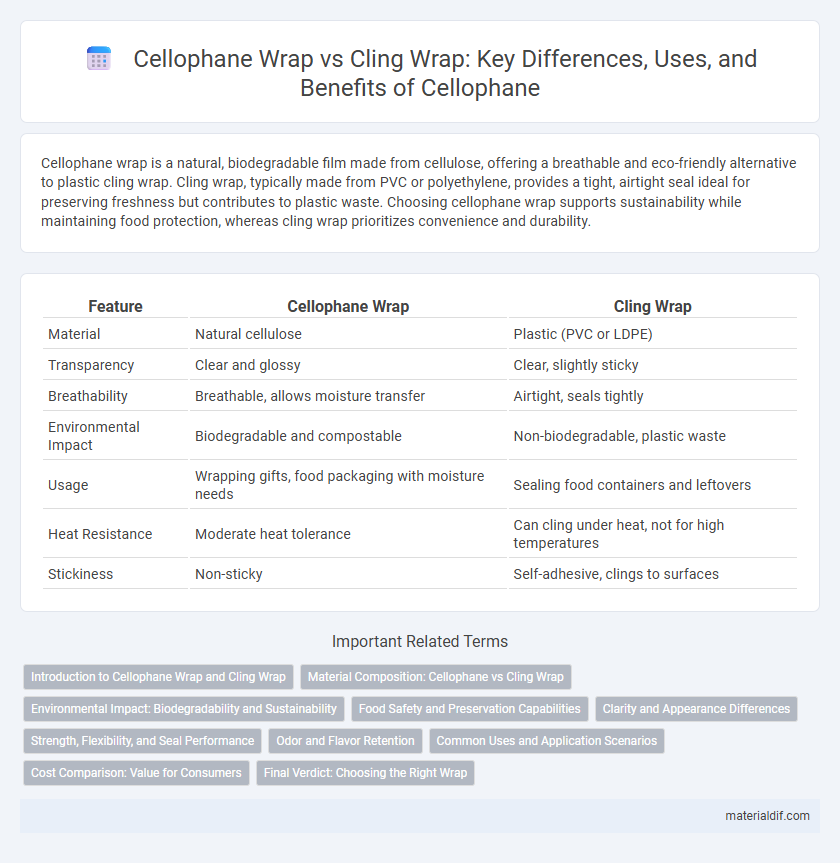Cellophane wrap is a natural, biodegradable film made from cellulose, offering a breathable and eco-friendly alternative to plastic cling wrap. Cling wrap, typically made from PVC or polyethylene, provides a tight, airtight seal ideal for preserving freshness but contributes to plastic waste. Choosing cellophane wrap supports sustainability while maintaining food protection, whereas cling wrap prioritizes convenience and durability.
Table of Comparison
| Feature | Cellophane Wrap | Cling Wrap |
|---|---|---|
| Material | Natural cellulose | Plastic (PVC or LDPE) |
| Transparency | Clear and glossy | Clear, slightly sticky |
| Breathability | Breathable, allows moisture transfer | Airtight, seals tightly |
| Environmental Impact | Biodegradable and compostable | Non-biodegradable, plastic waste |
| Usage | Wrapping gifts, food packaging with moisture needs | Sealing food containers and leftovers |
| Heat Resistance | Moderate heat tolerance | Can cling under heat, not for high temperatures |
| Stickiness | Non-sticky | Self-adhesive, clings to surfaces |
Introduction to Cellophane Wrap and Cling Wrap
Cellophane wrap is a thin, transparent film made from cellulose that offers excellent breathability and biodegradability, making it ideal for packaging fresh produce and food items. Cling wrap, typically made from plastic polymers like PVC or polyethylene, provides a tight, adhesive seal to preserve food freshness and prevent contamination. Both wraps serve distinct purposes in food storage, with cellophane emphasizing eco-friendliness and breathability, while cling wrap focuses on airtight sealing and flexibility.
Material Composition: Cellophane vs Cling Wrap
Cellophane wrap is made from regenerated cellulose derived from wood pulp, making it biodegradable and breathable, whereas cling wrap is typically composed of polyethylene or polyvinyl chloride (PVC), synthetic polymers that provide strong adhesion and moisture resistance. Cellophane's natural origin allows it to decompose more easily, while cling wrap's plastic composition contributes to durability and stretchability. The choice between cellophane and cling wrap often depends on environmental considerations and the need for airtight sealing.
Environmental Impact: Biodegradability and Sustainability
Cellophane wrap, derived from cellulose, biodegrades naturally within weeks in composting conditions, making it a sustainable alternative to cling wrap, which is typically made from non-biodegradable polyethylene plastics. The production of cellophane involves renewable materials and generates fewer carbon emissions compared to the petroleum-based processes for cling wrap. Choosing cellophane wrap supports environmental sustainability by reducing plastic waste and promoting compostability in waste management systems.
Food Safety and Preservation Capabilities
Cellophane wrap, derived from cellulose, is biodegradable and offers excellent breathability, reducing moisture buildup and preserving food freshness without trapping condensation. Cling wrap, typically made from PVC or polyethylene, provides a tighter seal that prevents air exposure but may trap moisture, leading to faster spoilage for some foods. Both wraps are food-safe, but cellophane is preferred for its natural properties and reduced risk of chemical migration, enhancing food preservation and safety.
Clarity and Appearance Differences
Cellophane wrap exhibits a natural matte finish that can appear slightly cloudy, providing a vintage aesthetic but less transparency compared to cling wrap. Cling wrap offers superior clarity and a glossy appearance, allowing clear visibility of the product inside, which enhances visual appeal on store shelves. The improved transparency of cling wrap makes it ideal for showcasing food freshness, whereas cellophane's muted sheen suits decorative packaging.
Strength, Flexibility, and Seal Performance
Cellophane wrap offers moderate strength and excellent biodegradability but tends to be less flexible and provides a weaker seal compared to cling wrap. Cling wrap is typically stronger and more adaptable, with superior sealing performance due to its ability to cling tightly to surfaces, ensuring airtight preservation. In food packaging, cling wrap's flexibility and reliable seal make it more effective for maintaining freshness than the relatively rigid and less adhesive cellophane wrap.
Odor and Flavor Retention
Cellophane wrap excels in odor and flavor retention due to its natural barrier properties, preventing the transfer of smells while maintaining food freshness. Cling wrap, typically made from polyethylene or PVC, offers a tighter seal but can sometimes trap odors within, potentially affecting flavor over time. For sensitive foods where preserving original taste and aroma is crucial, cellophane is often preferred for its superior breathability and minimal chemical impact.
Common Uses and Application Scenarios
Cellophane wrap, made from cellulose, is widely used for packaging fresh produce, bakery items, and gift wrapping due to its biodegradable and breathable properties that help preserve freshness. Cling wrap, typically composed of plastic polymers like polyethylene or PVC, is favored for sealing food containers, covering leftovers, and protecting meals in refrigeration because of its superior stretchability and airtight seal. Both wraps excel in kitchen use but differ in environmental impact and suitability for long-term storage or delicate packaging.
Cost Comparison: Value for Consumers
Cellophane wrap generally costs more than cling wrap due to its natural cellulose composition and biodegradable properties, offering eco-conscious consumers a sustainable option despite the higher price. Cling wrap, made from polyethylene, is typically cheaper and provides strong adhesion and flexibility, making it a cost-effective choice for everyday food storage. Consumers prioritizing budget often choose cling wrap, while those valuing environmental impact may invest in cellophane wrap despite its premium cost.
Final Verdict: Choosing the Right Wrap
Cellophane wrap offers biodegradable, breathable protection ideal for fresh produce, while cling wrap provides superior airtight sealing for long-term food preservation. Consider environmental impact and specific use cases such as moisture retention or freshness when selecting between wraps. Final verdict favors cling wrap for sealing efficiency, but cellophane is preferred for eco-friendly packaging and freshness maintenance.
Cellophane wrap vs Cling wrap Infographic

 materialdif.com
materialdif.com